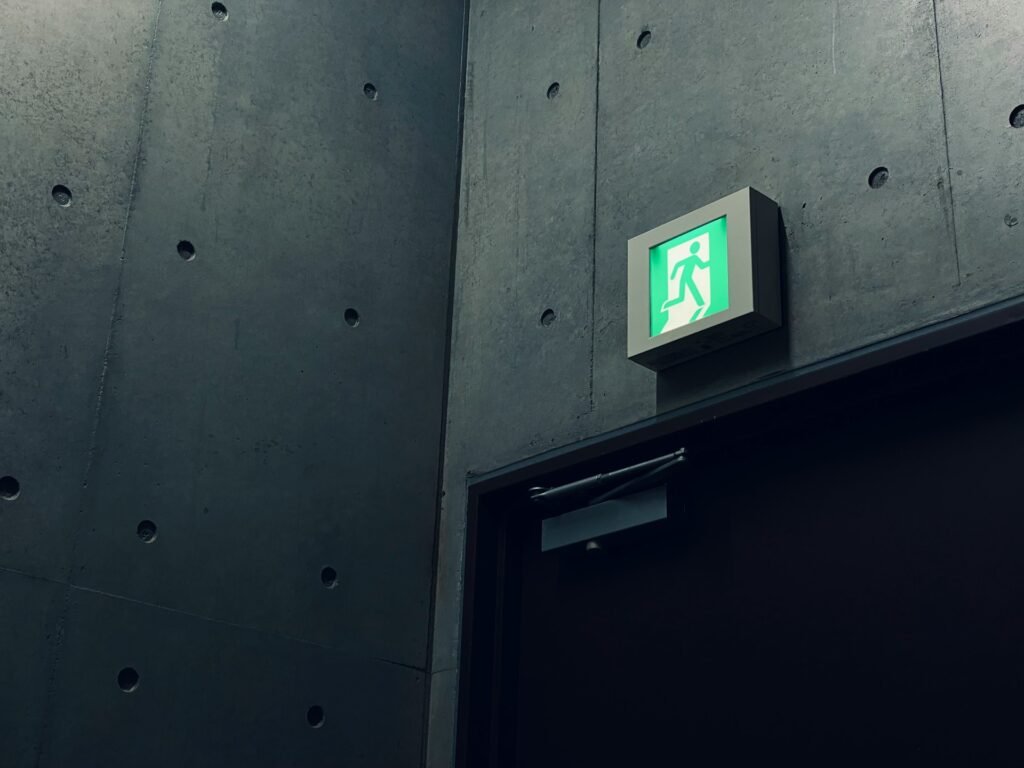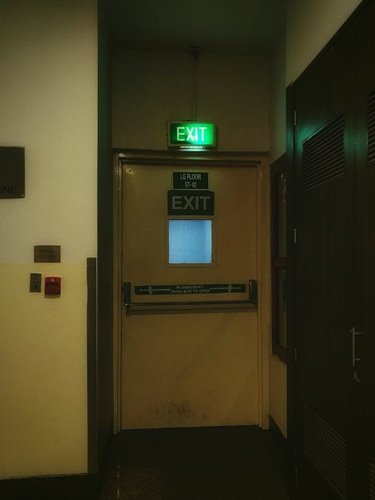All businesses in the UK, even the small, low-risk establishments, have to comply with the basic health and safety laws of the country. A lot of these laws relate to fire safety and how businesses should prevent or manage outbreaks in their buildings. According to the Fire Safety Order of 2005, businesses must provide adequate safety equipment, including fire-rated exit doors in specific areas of their building. This regulation is still upheld today, and failure to comply could lead to severe penalties.
Our post will serve as a guide to understanding fire-rated exit doors in the UK. You’ll learn about the type of fire door you may need and the strategic location to place it for proper compliance. We’ll also cover costly compliance mistakes businesses tend to make and how to avoid them. Let’s start with the basics.
What Are Fire-Rated Exit Doors
To understand the concept of fire-rated exit doors, you need to know the difference between fire-rated doors and fire exit doors.
Fire-rated doors (or simply fire doors) are designed to withstand a certain level of fire and smoke. They play a passive but important role in modern fire protection systems. The extent to which a door can resist fire and smoke is known as its fire rating. Most businesses install fire-rated doors internally or between two rooms. The entire fire door assembly, which includes the frame, leaves, handle, and other hardware, is responsible for protecting people in the building from fire and smoke.
Fire exit doors (or simply exit doors) are the final point of exit to the outside of the building. They are designed to open easily and quickly in case of an emergency. People inside can open an exit door with a panic bar or push pad, while those outside can open it using a secure keypad or key lock system. However, opening an exit door from the inside overrides any key lock, as its core purpose is easy egress. These doors often feature clear signs that can help users to understand their function.
Unlike fire doors, fire exit doors don’t have to be fire-rated. That means they don’t need the ability to withstand fire or smoke. All they need to do is open seamlessly from the inside. Now that you grasp the two concepts, you can understand the meaning of fire-rated exit doors.
A fire-rated exit door is a door designed to resist fire and smoke for a specific period while also providing safe egress from a building. It combines the functions of both fire doors and exit doors. These doors may look and function like regular doors but consist of heavier materials.
Why Fire-Rated Exit Doors Are Essential for UK Businesses

If you run a business in the UK, you will probably benefit from having fire-rated exit doors instead of regular doors. Let’s explore a few reasons why they are so useful.
Additional Safety
An exit door that keeps fire from spreading to nearby buildings and other parts of the compound offers an additional layer of safety. Fire-rated exit doors have multiple functions, as they also serve as a point of seamless egress during emergencies.
Compliance
The Fire Safety Order of 2005 has made fire doors and exits a requirement for certain buildings, including most UK businesses. To avoid getting hit with a penalty for non-compliance, your business may need to invest in fire-rated exit doors. You also have to ensure that its installation, rating, signage, and maintenance meet UK regulations.
Multiple Exits
Although buildings with multiple exits are not legally required to feature fire doors, they help to safeguard the lives of customers and staff. Using fire-rated exit doors, especially along hallways that lead to escape routes, can be crucial in an emergency. In case of a fire outbreak, you reduce the risk of jammed or burnt doors stopping people from reaching the escape route.
UK Fire Door Regulations

The Regulatory Reform (Fire Safety) Order 2005 is the main point of reference when it comes to fire safety laws for non-domestic buildings in the UK. This piece of legislation has received several updates and amendments in the past two decades, but the core regulations remain largely unchanged.
They apply to all UK business premises, charity organisation premises, and public buildings (government offices, schools, hospitals, and entertainment complexes). The actual document is too lengthy to post here, but we’ve provided a basic summary below:
- Every UK business must appoint a “Responsible Person” who will manage all fire safety precautions for the building, including all issues relating to fire and exit doors.
- The ”Responsible Person” will, on behalf of the business, ensure that a sufficient fire risk assessment is carried out on the building. This risk assessment is an in-depth review performed by someone with the appropriate experience and training, preferably a professional.
- A standard assessment should identify all of the major risk factors and recommend preventive measures or solutions, such as the strategic location of fire doors and the minimum ratings for such doors.
- Rated fire doors in openings leading to escape routes are a requirement for all UK businesses, including yours. However, proper assessment may reveal that fire-rated exit doors are required for your business. The safest option is to make all of your exit doors fire-rated.
- All businesses and their agents are required to educate their staff on the use of fire doors, exit doors, and escape routes.
- All businesses and their agents are required to carry out regular maintenance and inspection of fire doors, exit doors, and fire-rated exit doors.
FD30 vs. FD60 Fire Doors – What’s the Difference?
Fire ratings are issued based on how long, in minutes, the door and its components can withstand a specific level of fire and sometimes smoke. If you see a door labelled FD20 (“Fire Door 20”), it means that the door can withstand fire penetration for 20 minutes. The door may be rated FD20S, which denotes that it also offers smoke protection.
Two of the most common door ratings in the UK are FD30 and FD60. FD30 doors can prevent fire from spreading through them for 30 minutes, while FD60 doors can prevent fire from spreading through them for one hour (60 minutes). Hence, FD60 doors have a higher fire rating and offer more protection than FD30 doors.
BS 476-22 & EN 1634-1 Standards Explained
Both BS 476-22 and EN 1634-1 are standards of fire resistance testing. They serve as fire safety standards for doors, windows, shutters, or other building hardware. Before 2024, buildings in the UK used the BS 476-22. But more recently, the UK has begun adopting the newer EN 1634-1 standard. We can expect a full transition to the EN 1634-1 standard by 2029.
Both standards work fine in testing the fire resistance level of hardware. However, the EN 1634-1 standard involves a more rigorous testing process that is closer to real-life fire emergency conditions.
With BS 476-22, which was created in 1987, only one side of the door is tested. Also, a fire rating is awarded in minutes, according to how long the door maintained its integrity (30 minutes, 60 minutes, etc.). EN 1634-1 involves testing the two sides of the door under heavily controlled furnace temperatures. The doors receive a rating based on how many minutes they remain intact during testing. EN 1634-1 is the only standard that currently earns hardware a CE marking in Europe and a UKCA marking in the UK, making it the more valuable standard in those markets.
Fire Exit Door Installation & Maintenance Checklist
To comply with UK regulations and to ensure the safety of people in your building, standardise the installation and maintenance of all fire doors. The following is a simple checklist to that effect:
- Determine the appropriate fire rating of the doors using the findings of the risk assessment.
- Install the fire exit door in an accessible location free from obstruction.
- Hire a professional commercial door specialist in the UK for installation.
- Perform testing on the door opening and locking mechanism. It should provide quick egress in emergency situations.
- Ensure that all installed doors meet rigorous standards for durability and security.
- Display the appropriate signage on each door.
- After installation, regularly inspect all parts of the door, including the glass panels, push bar, lock system, and frames.
- Regularly check signage for fading, damage, and blockage.
- Set up a maintenance schedule. The process should involve lubricating the hinges and bars and tightening bolts and screws.
- In the case of damage, ensure prompt repairs by a professional door engineer.
Common Fire Exit Door Compliance Mistakes
Avoid these mistakes if you hope to comply with UK regulations on fire exit doors for non-domestic premises:
- Hiring incompetent contractors
- Failing to keep the gap between the door and its frame below the required maximum distance (typically 10mm for fire protection and 3mm for smoke protection)
- Using non-compliant hardware with fire doors, such as hinges or handles without the appropriate fire resistance rating
- Blocking emergency exits with boxes, office supplies, or other materials
- Failing to use intumescent strips that expand when hot, thereby offering better protection from fire and smoke
Failing to repair damage to doors as soon as possible.
Contact Door Engineers who offers automatic door installation in Birmingham to install fire-rated exit doors in UK.
According to regulations of the Fire Safety Order 2005, all UK businesses require fire doors. These doors serve as a line of defence in the event of a fire-related emergency.
An FD30 rating means that a door can withstand fire for 30 minutes, while an FD60 rating means that it can withstand fire for 60 minutes.
According to best practices, fire doors in the UK should be inspected at least once every six months. The building owner or a “responsible person” should carry out this inspection.
Fire doors should only be installed by a trained, competent, and certified professional. If that person is you, then you can install a fire door. If not, the recommended practice is to hire an experienced professional.
The penalty for non-compliance depends on the severity of the infraction. Punishment ranges from fines to imprisonment. There is no limit to the amount of the fine, but the maximum prison sentence for fire door non-compliance is two years.
Read More:

